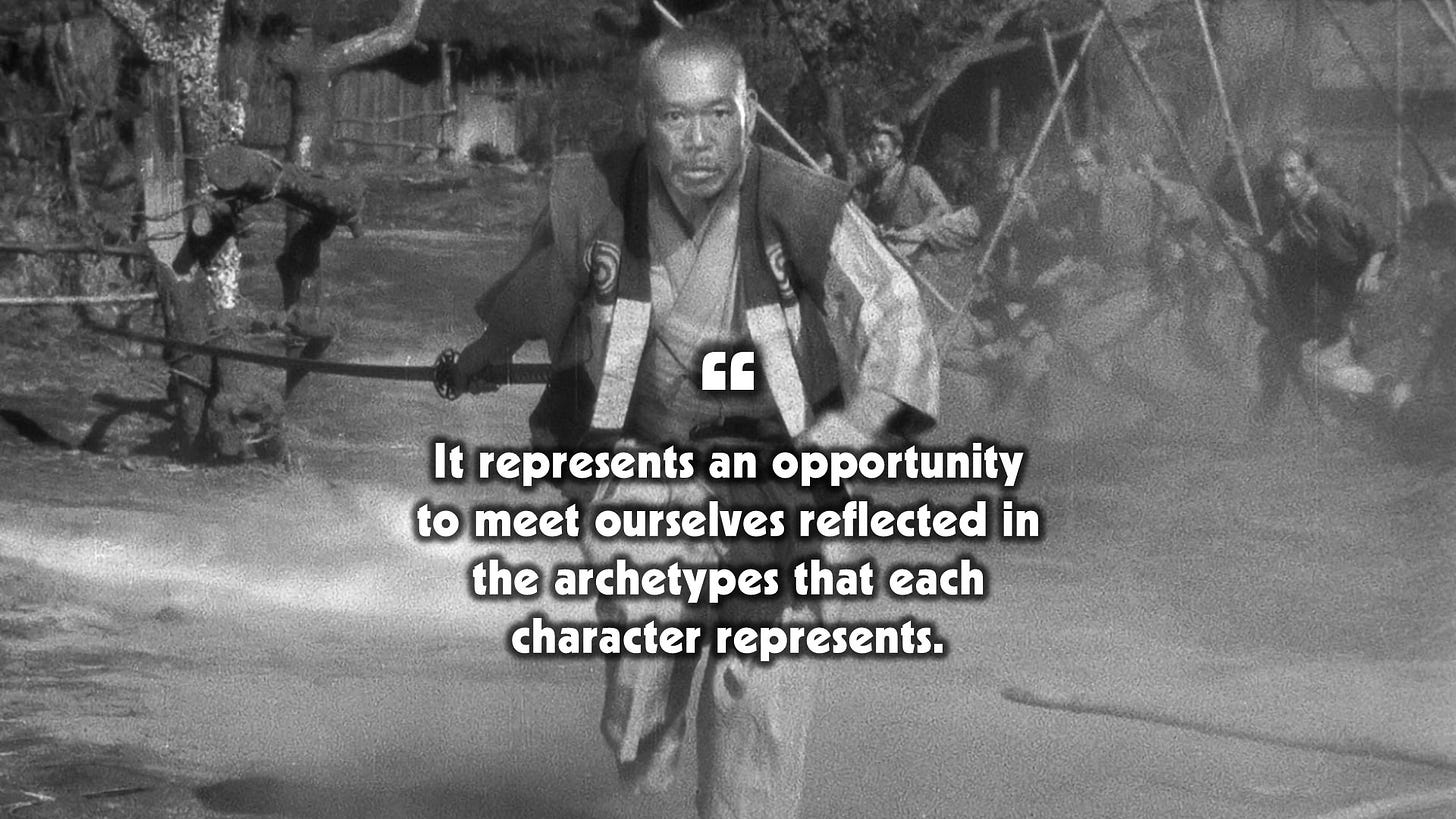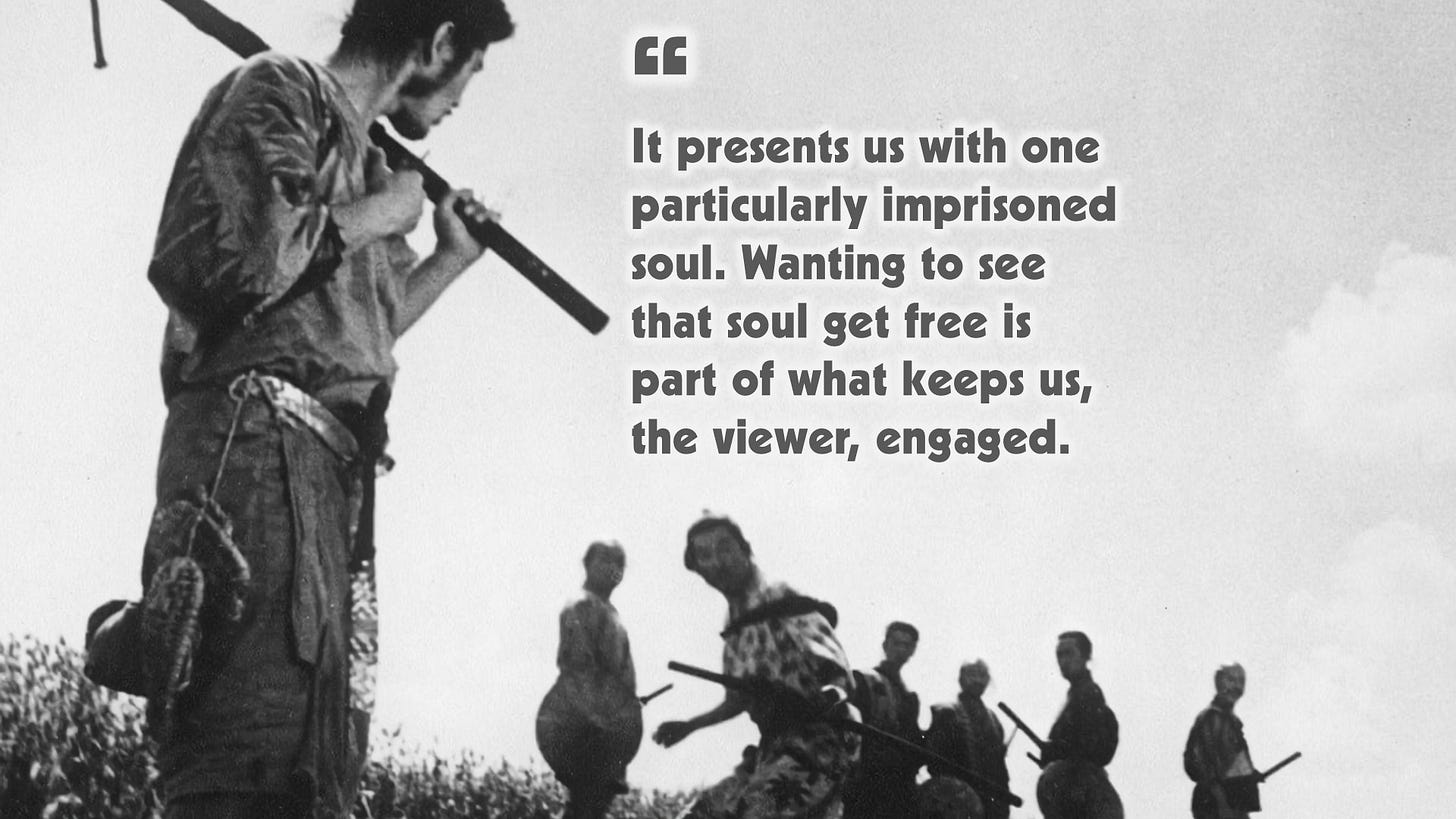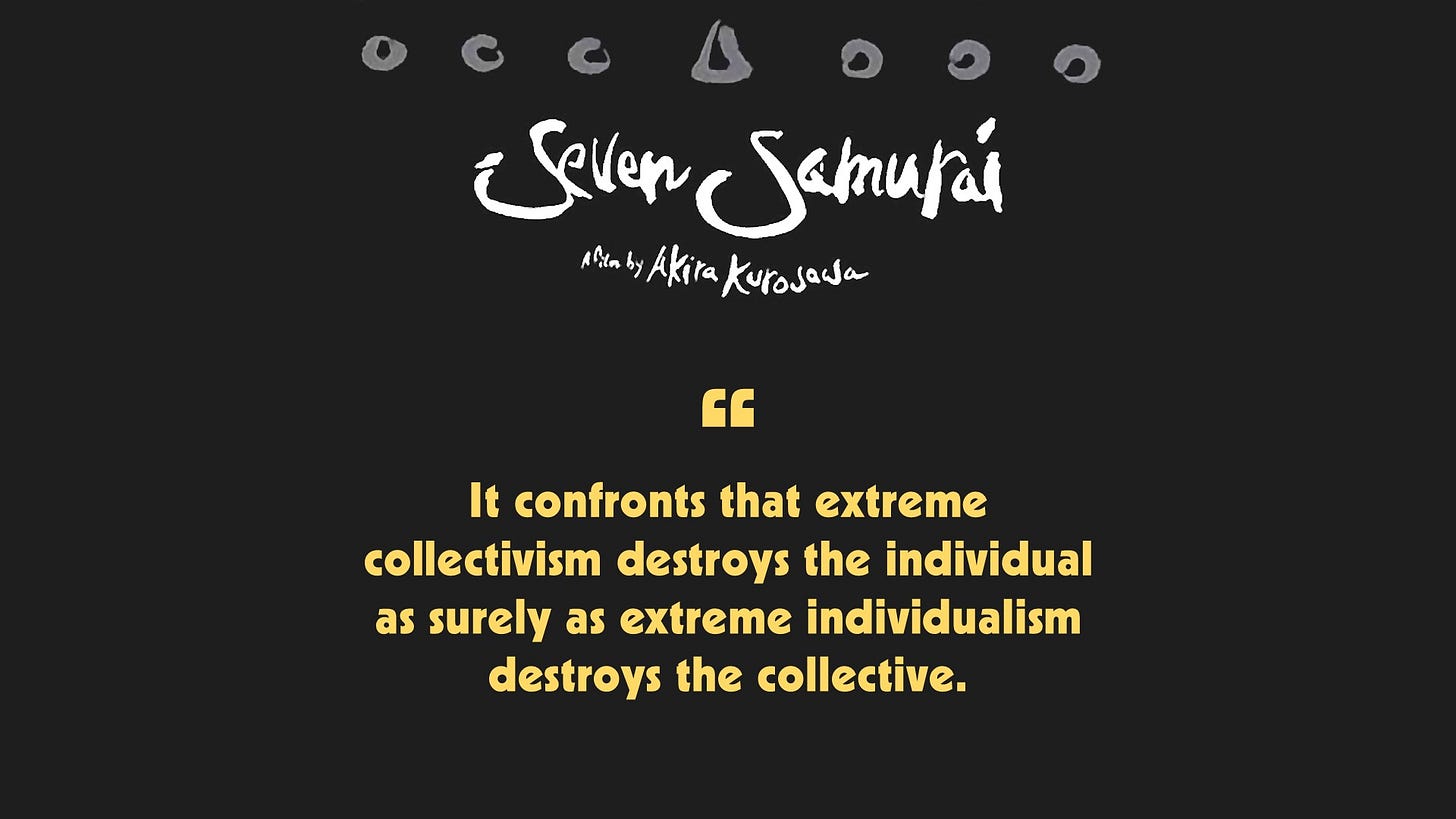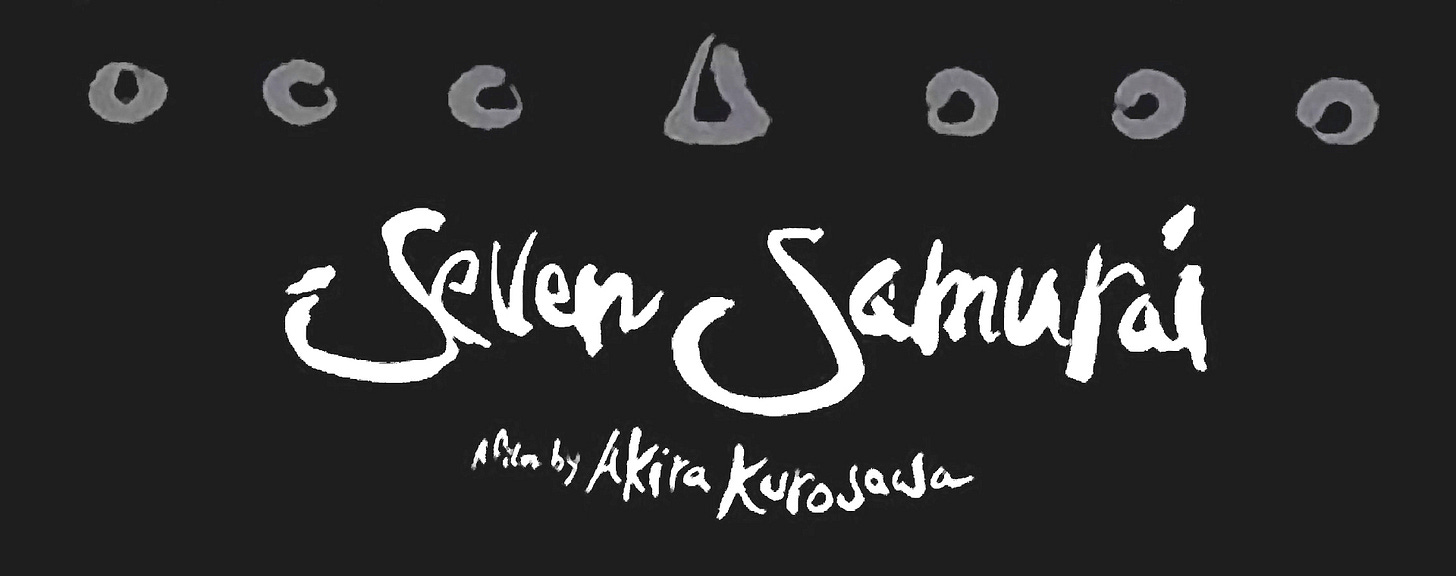SEVEN SAMURAI, directed by Akira Kurosawa, is an acknowledged classic and all-time great of world cinema. Loved by just about every influential director who ever lived, it’s lofty reputation is deserved.
This film has everything. It is so rich in character depth, social themes, symbolism, narrative, aesthetics, and is a master class in the language of cinema. It is so much more than a visually exciting spectacle.
I cannot possibly cover everything that I would love to say about this movie in anything less than a short book, but I’m compelled to at least articulate something about why I will never tire of this movie—and I’ll try and not be a mere clone of what evertone else is saying. This is my take.
Each Character is an Opportunity to Meet Ourselves in the Mirror
If anyone wonders how a film can be over three hours long and still be exciting, one only has to look at the combined range and depth of the characters. Surely, you don’t need me to tell you that there are a wide range of vividly drawn characters in this film, each with much to unpack.
The film famously tells the story of a community of poor farmers who hire an army of seven samurai to defend their village from bandits, and in doing so they, and us, the viewers, confront a myriad of societel complexities.
The farmers present us with a mix of fearful conflict avoiders, pessimists, idealists, and realists: a recognisable cross-section of every community, both in the large and in the small. In the dynamics between them, we have the dynamics of our own societies.
Through these characters, the film speaks to the inseparable duality of fear and courage, and of the personal losses that create both the fissures and the joins in our communities. Farmer Rikichi (Yoshio Tsuchiya), for example, represents the pain of losing his wife (Yukiko Shimazaki). Farmer Manzo (Kamatari Fujiwara), the fear of losing his daughter Shino (Keiko Tsushima).
Not wishing to make an unfortunate, degrading comparison between the samurai and the seven dwarves of Snow White, each of the samurai, like the dwarves represents something in us.
Leader Kambei (Takashi Shimura), whom we meet in the heroic act of rescuing a child from a desperate robber, represents humility, integrity, and dignity. Through him, the film proposes an instructive, idealistic equivalence between these qualities and clarity, impact, leadership, and, ultimately, greatness.
“I’m not accepting because of the farmers. I’m accepting because of you.”
Gorobei Katayama, speaking to Kambei.
As early as we meet Kambei, we meet Kikuchiyo (Toshiro Mifune), who seems strangely fascinated by Kambei. In him, we see a mix of admiration, curiosity, suspicious, reticence, and even contempt.
Competition is teased between Kikuchiyo and Kambei’s young apprentice Katsushiro (Isao Kimura) to be at Kambei’s side.
Among the other Samurai:
In Katsushiro, we meet youth, idealism, and hope.
In Gorebei (Yoshio Inaba), we meet loyalty and friendship.
In Heihachi (Minoru Chiaki), we meet enthusiasm and work ethic.
In Kyuzo (Seiji Miyaguchi), we meet quiet confidence and the private desire to master ourselves and sharpen skills for our own satisfaction.
Kyuzo is a character I find particularly fascinating. He does not need attention. He is not needy. He is grounded. He makes the pursuit of mastery for its own sake honourable. As a coach, I appreciate that.
For their virtues, each character is prone to moments of weakness, where they become their opposite. In the sequence where a vainglorious challenger challlenges Kyuzo to a senseless death duel, neither Kyuzo’s quiet confidence nor Kambei’s courage and integrity prevent the awful event.
Although the challenge sequence is, probably, principally a device to communicate Kyuzo’s economic mastery of the sword to us, rather than as a device to show us a flaw in Kyuzo’s and Kambei’s characters, it nevertheless communicates such a flaw, whether that was Kurosawa’s intention or not.
To quote one of my mentors, Bill Cumming, the capacity for all things resides in all of us, and this film represents an opportunity to meet ourselves reflected in the virtues and weaknesses that each character represents.
There’s an uplifting message about what we can find in ourselves when we need it, along with a stark warning about the possible intoxication of finding our capacity to violence, which is degrading even when it is necessary.
Kikuchiyo is a Particularly Imprisoned Soul
Kikuchiyo is the most complex of the characters:
He is signalled early on as having some deep, unresolved inner trauma. He is as much the mystery, and the hook, that will keep us interested, as he is the comic relief who will elevate our enjoyment of what could otherwise be an oppressively grim mood.
He is codified as an impulsive who doesn’t think his actions through. Sometimes, his impulsiveness inspired, courageous action. Sometimes, it’s clumsy, foolish mess-making. I remind you of my earlier submission: the capacity for all things resides in all of us.
He has something to prove to the others, which means he has something to prove to himself. That’s something that’s true of all of us.
He is given a particularly charming rapport with the farmers’ children. That codifies him as something of a child himself. That his mystery, unresolved trauma—his secret—is from his boyhood is the only clue Kurosawa gives.
He is also the character who is more aware of what he doesn’t want to be—of what he resents—more than he knows what he does want to be.
In Kikuchiro, the film presents us with one particularly imprisoned soul. Wanting to see that soul get free is what keeps us, the viewer, engaged. It’s one of the many master strokes of this film.
The Social Themes are Deep and Timeless
In Seven Samurai, we’re presented with familiar frustrations about our relationship with those who govern and tax, and the duality of our relationships with, and attitudes to, the military who protect us.
“Our rulers don’t care about us!”
“They should help us as well as tax us!”
Is it timeless that the soldiers who protect the land are rewarded and tributed when they’re needed, but shunned and starve when they’re not needed?
“We only have food to offer.”
“Then find hungry samurai.”
Is it timeless that those who enjoy the freedoms of the land have a complex need but don’t necessarily want relationship with their soldiers? That they’ll feed them for protection, but keep their daughters away from them?
One of the deep and potentially less self-comforting messages of Seven Samurai is that we’ll befriend those whom we mistrust, and we’ll bring those whom we would otherwise shun closer, if, but only if, our need is great enough.
It points at a certain selfishness.
The film more appealingly confronts prejudice and mockery. In the sequence where the farmers leave the village to try to recruit samurai, they become the subject of mockery and derision. There is comic relief in this sequence, which seems to be there partially to amuse us and interrupt the grimness, but it also seems to be a device to amplify our empathy towards the farmers and antipathy to those who laugh at poverty and the desperation of hunger.
We’re also confronted with the likelihood that while the bandits may be simple evildoers who delight in the suffering they cause, at least some of the thieves we meet in this troubled land may simply be desperate rather than evil, but in a Wild West style of justice, they must die too. It is presented coldly, without judgement, but points at something tragic.
Another prejudice we are confronted with is represented simply. Shino, farmer Manzo’s daughter, must become a boy to be safe.
“I’m only a ronin.”
Yes. Class and superiority, both within the ranks of the Samurai, and in the divide between the samurai and farmers. It is a somewhat subtle and hopeful message that only a ronin is the dignified leader of the Samurai.
Prejudices become accentuated when the samurai discover that the farmers have killed samurai in the past. Kikuchiyo acts as the unlikely bridge that can heal this rift, when it transpires that this would-be samurai is a farmer’s son, who feels kinship for both the farmers and the Samurai whilst outwardly resenting what each stands for and the worst of their ways.
The film is intentional to not equate poverty with shame, but is realistic in portraying that those in poverty might feel shame.
It Confronts Collectivism and Individualism
“Collective defence protects the individual. Individual defence destroys the individual.”
That’s the film in nutshell, right there.
Early on, we are presented that the farmers are divided on how to best protect their village. Some vote for action. Some for surrender. Some welcome the plan to hire Samurai. Some do not.
The crisis both brings the community together but also drives new fissures as our private needs and conflicting values and motivations clash with the increasing unity of the community.
Rikichi and Manzo represent the individuals who may most rebel against what is needed for the collective. Manzo’s fear for his daughter, and Rikichi’s pain for his lost wife, both become causes of friction, and then unification. Their stories tells us that everyone has triggers that might push them out from the collective and then motivate them to unity and action.
Incidentally, the identification—or creation in narrative—of a common enemy to unite us has been a tactic of manipulative, power-grabbing leadership for time immemorial. If Seven Samurai were made today, it might even hint at the threat of the bandits being a government concoction, or at least an exaggeration.
Does this message about collective defence make the film a manifesto for communism? No! Not at all. In fact, the film sensibly confronts that extreme collectivism destroys the individual as surely as extreme individualism destroys the collective. If anything, it’s a manifesto that the needs of individuals and the needs of the collective create a complex negotiation in which each needs to give some way to the other for both to survive and thrive.
The Broad Narrative is Brilliant and So are the Many Micro-Narratives
There are multiple hero’s journeys in Seven Samurai, making it dense even at the generous three-hour-plus run time.
I’ve already spoken of Kikiuchiro’s journey to set his imprisoned soul free. The film’s big payoff is how that happens, and that makes Kikuchiro, rather than Kambei, the central character.
Katsuchiro and Shino present us with the film’s love story, and the delight that love can blossom in, and even be forged by, grim circumstances.
I don’t want to unpack all the narratives here. You can do that by reading something like the BFI’s viewer guide. Here, I simply want to acknowledge the threading of multiple personal stories.
I also want to acknowledge the masterful pacing: the way Kurosawa neither rushes through, nor lingers too long, on each phase of the broad narrative, which travels through despair, struggle, optimism and lightness as the harvest arrives, fissures as personal needs come forth, and the unity that precedes the battle.
The ending is mixture of celebration and mourning, with communal singing being happy in some hearts, and masking tears in others. Masterful.
The Aesthetics and Cinematic Language are a Master Class
You can watch this film again and again just to study the aesthetics.
You can make a meal of analysing the spatial arrangement of the frame, and the use of lines and angles.
You can revel in the use of sound, such as the use of prominent bird sound in the grim opening, when the farmers despair at learning of the coming bandits.
As a film score fan, of course I wish to pay tribute to Fumio Hayasaka and his remarkable score. Notice how it goes from grim and funereal to proud and heroic in the transition for the farmers’ desperation to their search for Samurai.
Notice also how the proud heroism after the child rescue turns into the comedic scoring for Kikuchiyo, and how he easily finds a melancholy in the hero theme, that there is a loneliness in the dignity.
Hayasaka’s score achieves something I love in film scores. It is striking, bold, infectious, with memorable, stately themes, without distracting us from the film at all. It achieves the perfect balance.
It is also sparing, as great film music is, and absent when the film needs to be stark, gritty, and realistic rather than stylised.
One of my pet hates is when it feels like three hours of music is being crammed into a two-hour film. It turns the music into white noise, only able to have an affect by becoming even noiser than it may have already been. The scoring of Seven Samurai is a perfect instruction in how to not be that.
Speaking of the absence of score when the film needs to be stark, I love how Kurosawa heightens the dramatic bite in the film’s multiple violent climaxes by deliberately not glamorising them. It’s plaintive, realistic, and grim. The only stylization is a sparing, selective use of slow motion to accentuate.
Although the battle is long, as battles may be, the violence within the battle is brief, as real-life violence always is. The violence is also portrayed as somewhat degrading, even when necessary, as it also is in reality.
I’d like to close this woefully incomplete tribute on the film’s love story between Katsushiro and Shino, with one last comment on the beloved aesthetics of this film. I want to comment on how much I love that it starts in a beautiful meadow in which both are playfully absent from work, but Katsuchiro, with little awareness of self rebukes her for the same.
It’s a big film, but it’s the multiple little touches like that which elevate it.
If you’ve never seen it, I hope you enjoy Seven Samurai as much as I do.








